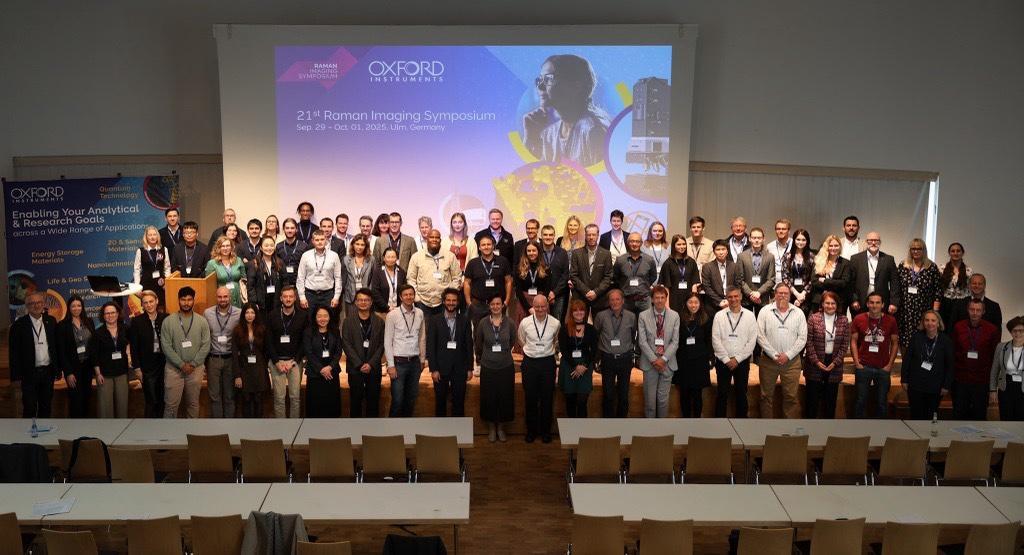30 October 2025
21st Raman Imaging Symposium: A 360-degree View of Raman Imaging Technology and Applications
Ulm, Germany – October 2025 – The 21st Raman Imaging Symposium, hosted by Oxford Instruments, welcomed an international audience of researchers to Ulm, Germany, for three days of scientific exchange, innovation, and inspiration.
Held from September 29 to October 1, the symposium featured a diverse program of presentations that showcased the versatility of Raman imaging across disciplines including materials science, life sciences, geosciences, and nanotechnology. Attendees from over 20 countries gathered to explore the latest developments in confocal Raman microscopy and its integration with complementary techniques.
The symposium opened with a keynote presentation by Prof. Dr. Keith Gordon (University of Otago, New Zealand), who shared his influential research on the application of chemometrics to unravel the complexities of advanced materials. Among the standout contributions were talks by Dr. Thomas Dieing (Oxford Instruments) and Prof. Dr. Sebastian Schlücker (University of Duisburg-Essen, Germany). Prof. Dr. Schlücker also delivered the evening lecture, which paid tribute to the legacy of Prof. Dr. Wolfgang Kiefer and his lasting impact on the Raman spectroscopy community. His presentation included the new findings of Prof. Dr. Kiefer on Raman-shifted Fraunhofer lines, offering fresh perspectives on a traditional approach for spectral analysis.
The further scientific program was structured into three thematic sessions that reflected the breadth of Raman imaging applications. “Insights to Biomaterials, Life Sciences and Pharmaceutical Research” explored the role of Raman spectroscopy in understanding biological systems, drug delivery, and tissue characterization. The session “Diamond in Geological and Industrial Processes” focused on the unique properties of diamond and its relevance in both natural and engineered contexts, including high-pressure research and industrial applications. Cutting-edge research on advanced materials such as 2D structures, polymers, and semiconductors was showcased in the “Exploring Novel Materials” session, emphasizing Raman imaging’s contribution to materials development and characterization.
The “Best Poster Award" went to Max Naumann from the Leibniz Institute for Photonic Technology in Jena, Germany, for his work on “Label-free Cell Characterization using Raman Imaging – From in-vitro cells to cells in a 3D ex-vivo tissue model”
In addition to the scientific sessions, the symposium offered hands-on instrument demonstrations, a poster session, and ample networking opportunities. The interactive format encouraged dialogues between users and developers, fostering collaboration and sparking ideas.
A special moment was the unveiling of Oxford Instruments’ brand-new witec360 Raman microscope on stage by Dr. Benjamin Tordoff, General Manager of Oxford Instruments’ Raman Microscopy site and EMEA President Maria Angeles Diaz. After its official release less than a week before the event, the symposium’s participants were the first to see the new system in action during the on-site demonstrations.
“The 21st edition of our symposium once again demonstrated the strength and diversity of the Raman imaging technique,” said Dr. Benjamin Tordoff. “We’re proud to provide an interdisciplinary platform where researchers can share their discoveries and help shape the future of spectroscopy.”
The symposium concluded with a look ahead to emerging trends in Raman technology and its growing role in solving complex analytical challenges. Planning is already underway for the 22nd Raman Imaging Symposium on September 28 – 30 2026, which promises to continue the tradition of excellence and innovation.
For more information on the Raman Imaging Symposium, visit www.raman-symposium.com


